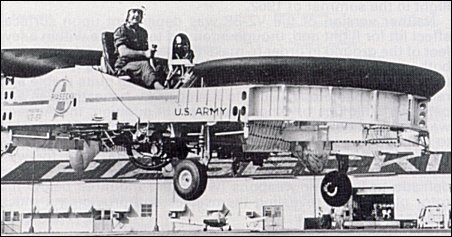
| Piasecki 59 / VZ-8P "Airgeep" 1962 |  |
 |

| Piasecki 59 / VZ-8P "Airgeep" 1962 |  |
 |
|
In 1957 Piasecki Aircraft was awarded an Army Transportation Research Command contract for the development of a 'flying jeep' - type VTOL research vehicle capable of operating at extremely low altitudes at speeds up to 110kph. Piasecki, at that time a leader in vertical lift research and development, produced an innovative design dubbed the Model 59K "Sky Car". The craft was built around two tandem, three-bladed, ducted rotors driven by two 135kW Lycoming piston engines. Both powerplants were connected to a single central gearbox so that both rotors would continue to turn even if one engine failed. The "Sky Car" had fairly conventional helicopter-type controls which provided directional stability through a series of hinged vanes mounted under each rotor duct. The craft had fixed tricycle wheeled landing gear, and accommodated its single pilot and one passenger in seats sited between the two rotor ducts. The first of two Model 59 examples ordered by the Army made its initial free flight in October 1958 and, renamed "Airgeep" by Piasecki, was turned over to the Army shortly thereafter. The machine was subsequently given the designation VZ-8P (the "P" indicating Piasecki). Shortly after being accepted by the Army the VZ-8P was fitted with a single 315kW Turbomeca Artouste IIB turbine engine in place of its twin Lycoming pistons, and its first turbine-powered flight took place in June 1959. The craft was subsequently loaned to the Navy for evaluation (as the Model 59N), and upon its return to the Army its Artouste IIB was replaced by a lighter and more powerful AiResearch 331-6 turbine. The second VZ-8P incorporated several significant design changes and was, accordingly, dubbed the Model 59H "Airgeep II" by Piasecki and the VZ-8P (B) by the Army.
|